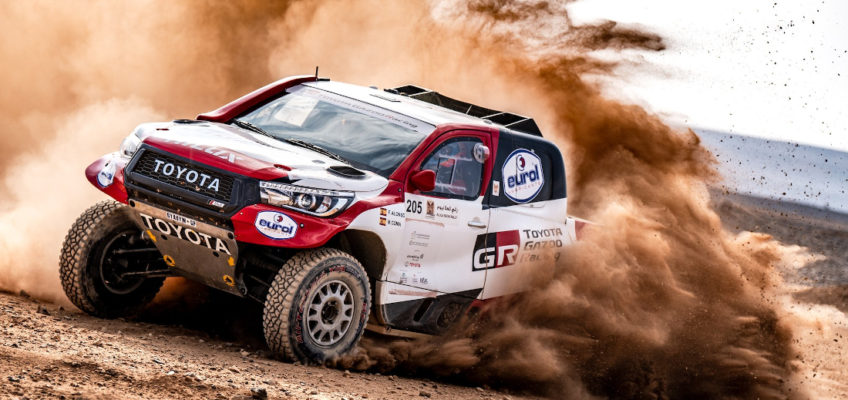Fernando Alonso and his co-pilot Marc Coma have successfully completed this past Tuesday their preparation for the Dakar Rally which will take place for the first time in Saudi Arabia from the 5th to the 17th of January. The pair, onboard their Hilux 4×4 (Toyota GAZOO Racing South Africa-Overdrive team), have concluded their last three days of tests (8th -10th of December), which consisted of 600 kilometres on the Abu Dhabi desert.
Both teammates have confirmed via social networks that the adaptation process has been a success: “A very good three days in Abu Dhabi in the last of the tests over dunes before the Dakar. Good progress. We are ready” – they have declared.
In preparation for a rally which route will run 70% on sand, Alonso and Coma have performed these latest tests on such surface for as long as possible. One of the main objectives for the Spanish rookie has been to build up kilometres and experience in such a hostile environment.
Despite the overall good sensations, both the Northern Spanish and the Catalan drivers have suffered a small accident on the last day of tests. After flying over a dune, they partially damaged their front suspension forcing them both out of the car to attempt and repair the damage.
Then, another Hilux that was training with them and was driven by Jesus Calleja (for whom this will be his fourth Dakar rally), towed them until they were finally free from the sand. In the end, the three Spaniards resume their training without further incidents.
Alonso and Coma: The road to the Dakar
After having a go at the Toyota Hilux next to Giniel De Villiers in South Africa, Fernando Alonso finally had his first experience with Marc Coma as a co-pilot in Namibia. From that moment on, the two Spanish drivers haven’t stopped training in preparation for the most famous and toughest – both for the drivers and their machines – race on the planet.
Soon after their first experience, they returned to the Namibian desert for more testing before finally moving their training schedule to Europe. Once in the Old Continent, they travelled to Poland (2nd -3rd September) to try out some extremely fast tracks.
The objective was to acquire a good rhythm and set of skills under those kinds of circumstances. After Poland, they wanted to put their abilities to the test in a real-life setting and against renowned rivals such as the Belgian De Villiers. And so, in mid-September, they went back to Africa to take part in the Lichtenburg 400, a race which is part of the South African Cross-Country Series (SACCS). The race was a real rite of passage for Alonso.
After his car overturned, Alonso had to drive while holding onto his broken windshield with one hand for over 200 kilometres. After having it replaced, the glass broke again after a bird crashed against it. It was in such a turbulent way that Alonso started to realise how hard rally competitions actually are, but rather than being disheartened, it made him more determined.
Images: Toyota.





Leave a Reply